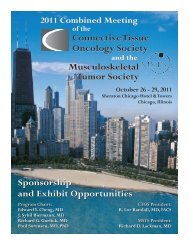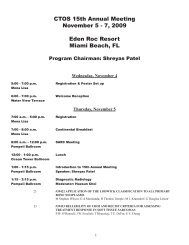207 Poster Session 2 - Connective Tissue Oncology Society
207 Poster Session 2 - Connective Tissue Oncology Society
207 Poster Session 2 - Connective Tissue Oncology Society
You also want an ePaper? Increase the reach of your titles
YUMPU automatically turns print PDFs into web optimized ePapers that Google loves.
Scientific <strong>Poster</strong>s – <strong>Poster</strong> <strong>Session</strong> 2<strong>Poster</strong> #159SELECTIVE TARGETING OF THE PI3K/AKT/MTORPATHWAYS IN SOFT TISSUE SARCOMA BYCOMPOUNDS IDENTIFIED IN A SMALLMOLECULE SCREENLeah Kabaroff 1 ; Yael Babichev 1 ; David Uehling 2 ;Methvin Isaac 2 ; Rima Al-Awar 2 ; Rebecca Gladdy 31Samuel Lunenfeld Research Institute, Mount Sinai Hospital,Toronto, ON, Canada; 2 Medicinal Chemistry Platform,Ontario Institute for Cancer Research, Toronto, ON, Canada;3Department of Surgery, University of Toronto,Toronto, ON, CanadaObjective: Soft tissue sarcomas (STS) are rare connectivetissues cancers. Leiomyosarcoma (LMS) is a common STSsubtype, characterized by complex karyotypes. Althoughthe genetics of LMS are not well defined, loss of the tumorsuppressors p53 and Rb, as well as alterations in the PI3K/Akt/mTOR pathway including constitutive activation ofthe PI3K receptor, loss of PTEN and/or RICTOR amplificationare frequent. The mainstay of treatment for LMS issurgery as current chemotherapy is marginally effectiveand is associated with toxicity. Therefore, there is a needto develop more effective drug therapy.Methods: LMS cell lines were screened with the OICRkinase library (n=400 compounds) and a cell viability assaywas used to identify potentially effective compounds.The top 10% of hits underwent secondary validation todetermine their EC50 and western blots were performedto confirm selective drug action. The efficacy of combinationdrug therapy with doxorubicin (Dox) in vitro wasanalyzed using the Calcusyn program after treatment withone of three dosing schedules which included: concurrenttreatment, initial treatment with a selective compound (SC)followed by Dox, or initial treatment with Dox followedby the selective compound.Results: In our primary screen the most potent compoundstargeted the PI3K/Akt/mTOR pathway (57%), cell cycle(20%) and receptor tyrosine kinases (23%). EC50 determinationwas performed and drug selection criteria focusedon the PI3K/mTOR inhibitors BEZ235 and BKM120(EC50=73nM and 513nM respectively). We confirmedselective activity of these compounds by measuring theeffect on downstream PI3K/Akt/mTOR targets by westernblotting. In SKLMS1, a commercial cell line, use of the dualPI3K/mTOR inhibitor BEZ235, showed synergism withDox in vitro in all dosing strategies. In our primary LMScell line STS 39, derived from a patient sample, synergisticeffects with concurrent treatment and Dox pre-treated cellswas observed with BEZ235. In contrast, the PI3K inhibitorBKM120, showed no synergistic effects with Dox in the celllines examined. We are currently determining the effects ofcombination therapy in vivo using concurrent treatmentwith BEZ235.Conclusion: Since the PI3K/mTOR pathway is commonlydysregulated in STS, including LMS, the use of selectiveinhibitors of this pathway, which can also be synergisticwith doxorubicin, warrants further pre-clinical testing asa possible novel treatment for sarcoma patients.<strong>Poster</strong> #160CHARACTERISTICS OF ALT ARE INHIBITED BYTELOMERASE ACTIVITYMatthew Plantinga, PhD 1 ; Kara M. Pascarelli 1 ;Anna S. Merkel 1 ; Margaret von Mehren 2 ; Dina Lev 3 ;Dominique Broccoli 11Curtis and Elizabeth Anderson Cancer Institute, MemorialUniversity Medical Center, Savannah, GA, USA;2Fox Chase Cancer Center, Philadelphia, PA, USA;3MD Anderson Cancer Center, Houston, TX, USAObjective: Telomere maintenance is an essential characteristicof cancer cells, necessary to avoid senescence inducedby replication-associated telomere shortening. While mostcommonly achieved by activation of telomerase, telomerescan also be maintained by a recombination-basedmechanism termed Alternative Lengthening of Telomeres(ALT). Cells using ALT are characterized by the presenceof ALT-associated PML bodies (APBs), in which telomeresassociate with the PML nuclear body, as well as long,heterogeneously sized telomeres, extra-chromosomal telomericcircular DNA, and elevated telomeric recombination.ALT is rarely used in carcinomas, but occurs at significantfrequencies among sarcomas. Tumors using ALT, by lackingtelomerase, are expected to be refractory to treatmentwith telomerase inhibitors. The limited understanding ofthe ALT pathway does not present any similarly criticaltarget for ALT-specific treatment; thus, insight into theALT mechanism is critical to developing better treatmentfor these tumors.Methods: APBs and single-stranded circular DNA containingthe C-rich telomeric sequence (C-circles) were detectedusing established assays in a panel of 31 de-differentiated(DDLPS), 11 pleomorphic liposarcomas (PLS), and in ALTcell lines.Results: Although both telomerase and ALT were observedin subsets of DDLPS, no telomerase-positive tumors werepresent among PLS. Tumors containing APBs but lackingtelomerase expression always contained C-circles, andthese C-circles were never present in the absence of APBs,indicating a tight link between these features in ALT cells.A rare subgroup of tumors showing evidence of telomeremaintenance by both telomerase and ALT did not containC-circles. We hypothesized that telomerase expression disruptsthe tight link between APBs and C-circles. To test thishypothesis, we used ALT cell lines that were engineered to250






